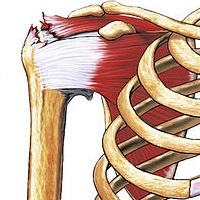
Photo from wikipedia
OBJECTIVES Conceptualisation of a clinically-relevant group of conditions as a region-based, load-related musculoskeletal pain condition ('tibial loading pain') to enable identification of evidence of treatment effect from load-modifying interventions. DESIGN… Click to show full abstract
OBJECTIVES Conceptualisation of a clinically-relevant group of conditions as a region-based, load-related musculoskeletal pain condition ('tibial loading pain') to enable identification of evidence of treatment effect from load-modifying interventions. DESIGN Systematic review and evidence synthesis based on a developed and justified theoretical position. METHODS Musculoskeletal pain localised to the tibial (shin) region and consistent with clinical presentations of an exercise/activity-related onset mechanism, was conceptualised as a group of conditions ('tibial loading pain') that could be reasoned to respond to load modifying interventions. Five databases were searched for randomized controlled studies investigating any load-modifying intervention for pain in the anterior-anteromedial lower leg (shin). Study quality was evaluated (Risk of Bias Tool Version 2) and level of certainty for the findings assessed. RESULTS Six studies reporting seven comparisons were included. Interventions included braces, anti-pronation taping, compression stocking and a stretch + strengthening programme. All included studies were assessed as having unclear or high risk of bias. The review found no evidence of beneficial effect from any of the load-modifying interventions on symptoms, physical performance or biomechanical measures, apart from a possible benefit of anti-pronation 'kinesio' taping. There was very low certainty evidence that kinesio taping improves pain and pain-free hopping distance after one week. The braces were associated with minor adverse effects and problems with acceptability. CONCLUSIONS None of the treatments investigated by the included studies can be recommended. Conceptualisation of the problem as regional, primarily loading-related pain rather than as multiple distinct pathoanatomically-based conditions, and clearer load-modifying hypotheses for interventions are recommended.
Journal Title: Journal of science and medicine in sport
Year Published: 2021
Link to full text (if available)
Share on Social Media: Sign Up to like & get
recommendations!